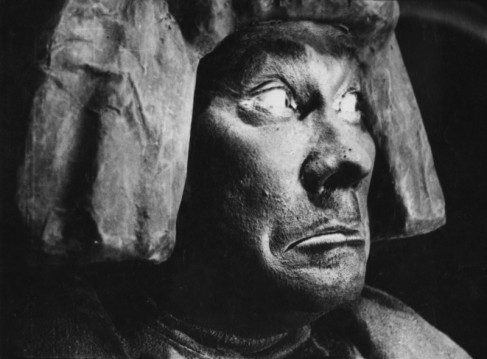The Golem: How He Came Into the World (1920)
March 15, 2013 Leave a comment
- directed by Paul Wegener and Carl Boese
- starring Albert Steinrück, Paul Wegener, Lyda Salmonova, Ernst Deutsch, Lothar Müthel, Otto Gebühr
- A Jewish rabbi creates and brings to life the Golem to protect the Jews of Prague from persecution.
This was Paul Wegener’s third film based on the novel by Gustav Meyrink but the only one that still exists today. How He Came Into the World is a prequel to his first two efforts and the film’s importance is felt to this day for its beautiful Expressionist style and for it being something of a forebearer to the Universal horror explosion that occurred a little over a decade later. Any answers searched for as to the right tone to strike overall or how a monstrous creation should behave on screen in those 1930’s horror films, specifically the Karloff ones, were properly flushed out by the creatively mighty team behind The Golem.
There were a few direct hat tips in Frankenstein, the obvious ones being the creation’s physicality and the two monsters’ interactions with a cute and innocent child during their violent rampages. The Golem’s influence goes even further to films like The Mummy (directed by The Golem’s cinematographer Karl Freund) and all the way into 50’s science fiction and beyond. The concept of a creation with an expressed purpose that slowly degrades into moral ambiguity and uncontrollable violence has been explored in film from all angles. The Golem happened to be one of the first, if not the first.
This was my favorite execution of German Expressionism on film because it feels like Wegener and Boese, with designer Hans Poelzig and cinematographer Karl Freund, were able to seamlessly blend the angular and larger than life design elements into scenes that still felt traditional in a way. Where The Cabinet of Dr. Caligari flaunted its angry-looking and over the top sets and artwork to convey the psychotic nature of the story, it felt like The Golem’s Expressionism was more warm and fluid, a good portion of which came from the placement of the camera itself. There were surely the requisite cartoonish settings, but one thing I said to myself over and over was, I’ve never seen a camera in this part of the room before. It was a way, I’m assuming, to achieve Expressionist angles and have the main action off-centered even in settings that were light on design elements. The film looked amazing throughout and Freund clearly utilized many different techniques to get it to that level.
Story-wise, I appreciated the religious and spiritual depth given to what was basically a monster movie. What was unique was that it wasn’t a monster made out of madness like Frankenstein’s or one to carry out world domination, but instead designed as the physical embodiment of the spirit of the Prague Ghetto and the Jewish faith in general. One thing I’m unclear about is what exactly the Rabbi wanted the Golem to do to protect the exiled Jews. The Golem saves the day by coincidence really as he prevents the ceiling from falling on the Rose Festival gatherers, but what if that didn’t happen? It was the Rabbi’s magical presentation that caused it to fall in the first place. I get the Golem as a symbol of strength for the Jewish community during a difficult time, but as an imposing figure I think a lot of the details of the plan were left unexplained.
The priority was in the hitting of the necessary beats of the character’s journey—creation, exhibition of strength, saves the day, darkens, even darker, redemption—instead of following through with the original story introduced in the beginning. For a movie called The Golem, I’d say that’s appropriate, but a few points were left dangling and it was all rushed a little too much for me. Still an absolute classic for its look, mood, and influence.
